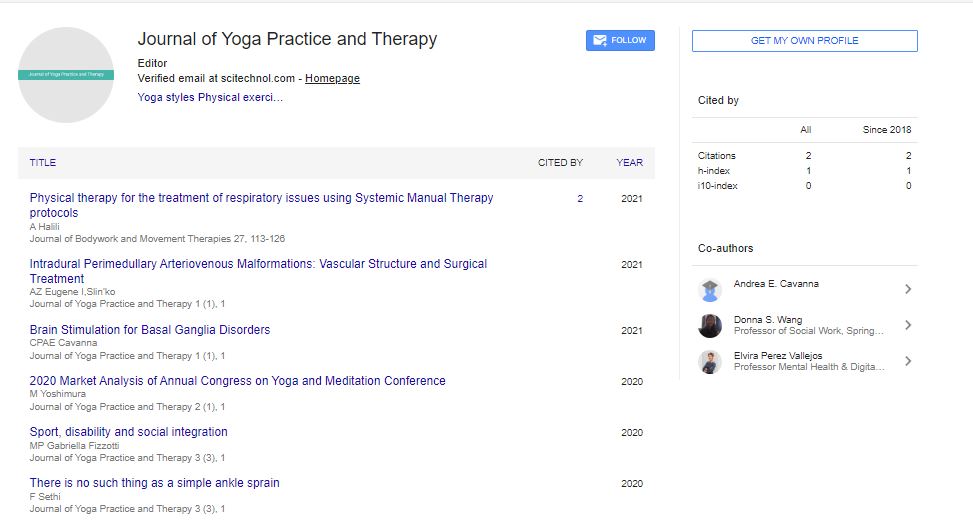Commentary, J Yoga Therap Vol: 6 Issue: 4
Restorative Yoga for Deep Body Relaxation: Benefits, Practice and Healing Power
Kaitlyn Coleton*
1Department of Biobehavioral Sciences, Columbia University, New York, US
*Corresponding Author: Kaitlyn Coleton,
Department of Biobehavioral Sciences,
Columbia University, New York, US
E-mail: Savimeoa@gmail.com
Received date: 24 November, 2023, Manuscript No. JYPTY-24-124138;
Editor assigned date: 28 November, 2023, Pre-QC No. JYPTY-24-124138 (PQ);
Reviewed date: 14 December, 2023, QC No. JYPTY-24-124138;
Revised date: 21 December, 2023, Manuscript No. JYPTY-24-124138 (R);
Published date: 28 December, 2023, DOI: 10.4172/JYPTY.1000140
Citation: Coleton K (2023) Restorative Yoga for Deep Body Relaxation: Benefits, Practice and Healing Power. Int J Yoga Therap 6:4.
Description
In the fast-paced and often hectic rhythm of contemporary life, the practice of restorative yoga emerges as a sanctuary for deep relaxation and rejuvenation. This manuscript delves into the essence of restorative yoga-a gentle and therapeutic practice that invites individuals to surrender, release tension, and experience profound relaxation in body and mind.
The foundations of restorative yoga
Origins and philosophy: Rooted in the teachings of b.k.s. iyengar and inspired by the principles of vipassana meditation, restorative yoga offers a gentle approach to the ancient art of yoga. It emphasizes supported poses, stillness, and extended holds to facilitate relaxation and renewal.
The principle of support: At the heart of restorative yoga lies the principle of support. Through the use of props-blankets, bolsters, blocks, and straps-practitioners are cradled into poses that require minimal effort, allowing the body to surrender and the mind to quieten.
The practice of stillness and surrender
Gentle asanas for relaxation: Restorative yoga features a curated selection of gentle asanas, carefully chosen to induce a state of relaxation. These poses, such as supported child’s pose, legs up the wall, and reclining bound angle pose, provide a soothing and nurturing environment for the body to unwind.
Extended holds and deep release: Unlike dynamic forms of yoga, restorative yoga encourages extended holds in each pose. The prolonged duration, often ranging from 5 to 20 minutes, allows the body to release deeply held tension and stress, promoting a sense of surrender and tranquility.
The therapeutic benefits of restorative yoga
Physical relaxation and recovery: The prolonged and supported nature of restorative yoga poses facilitates physical relaxation. This, in turn, promotes recovery by releasing muscle tension, improving circulation, and enhancing the body's ability to heal itself.
Stress reduction and nervous system balance: The practice of restorative yoga engages the parasympathetic nervous system, also known as the "rest and digest" system. By inducing a relaxation response, it helps counteract the effects of chronic stress, reducing cortisol levels and promoting an overall sense of calm.
Mental clarity and emotional well-being: The gentle nature of restorative yoga poses creates a space for mental clarity and emotional balance. As the body relaxes, the mind follows suit, allowing practitioners to navigate the currents of their thoughts with greater ease and cultivating emotional resilience.
The art of breath and mindfulness
Conscious breath in restorative yoga: Breath awareness is integral to the practice of restorative yoga. The slow, conscious breaths guide practitioners into a deeper state of relaxation, encouraging a mindful connection between breath and body. The breath becomes a gentle anchor, grounding individuals in the present moment.
Mindfulness and the present moment: Restorative yoga is a practice of mindfulness. As individuals settle into each pose, they are invited to let go of distractions and embrace the present moment. This mindful awareness fosters a profound sense of peace and acceptance.
Creating a restorative yoga space
Setting the atmosphere: Creating an environment conducive to relaxation is crucial in restorative yoga. Dim lighting, soft music, and the use of props contribute to a soothing atmosphere that enhances the overall experience.
The role of props: Props play a pivotal role in restorative yoga, providing support and comfort. Properly placed bolsters, blankets, and blocks help individuals achieve optimal alignment, allowing for a deeper sense of relaxation in each pose.
Conclusion
In the art of restorative yoga, the magic lies in stillness and surrender. Beyond the physical poses, it becomes a practice of selfnurturing- a sanctuary where the demands of the external world fade away, and individuals are invited to retreat into the embrace of deep relaxation. As practitioners embark on this journey of stillness and surrender, they discover not only the physical benefits of tension release and rejuvenation but also a profound connection to the peace that resides within. Restorative yoga becomes a gateway to the healing power of stillness-a practice that transcends the mat and permeates the tapestry of daily life, fostering a sense of balance, resilience, and an enduring well-being that emanates from the core of one's being.
 Spanish
Spanish  Chinese
Chinese  Russian
Russian  German
German  French
French  Japanese
Japanese  Portuguese
Portuguese  Hindi
Hindi 